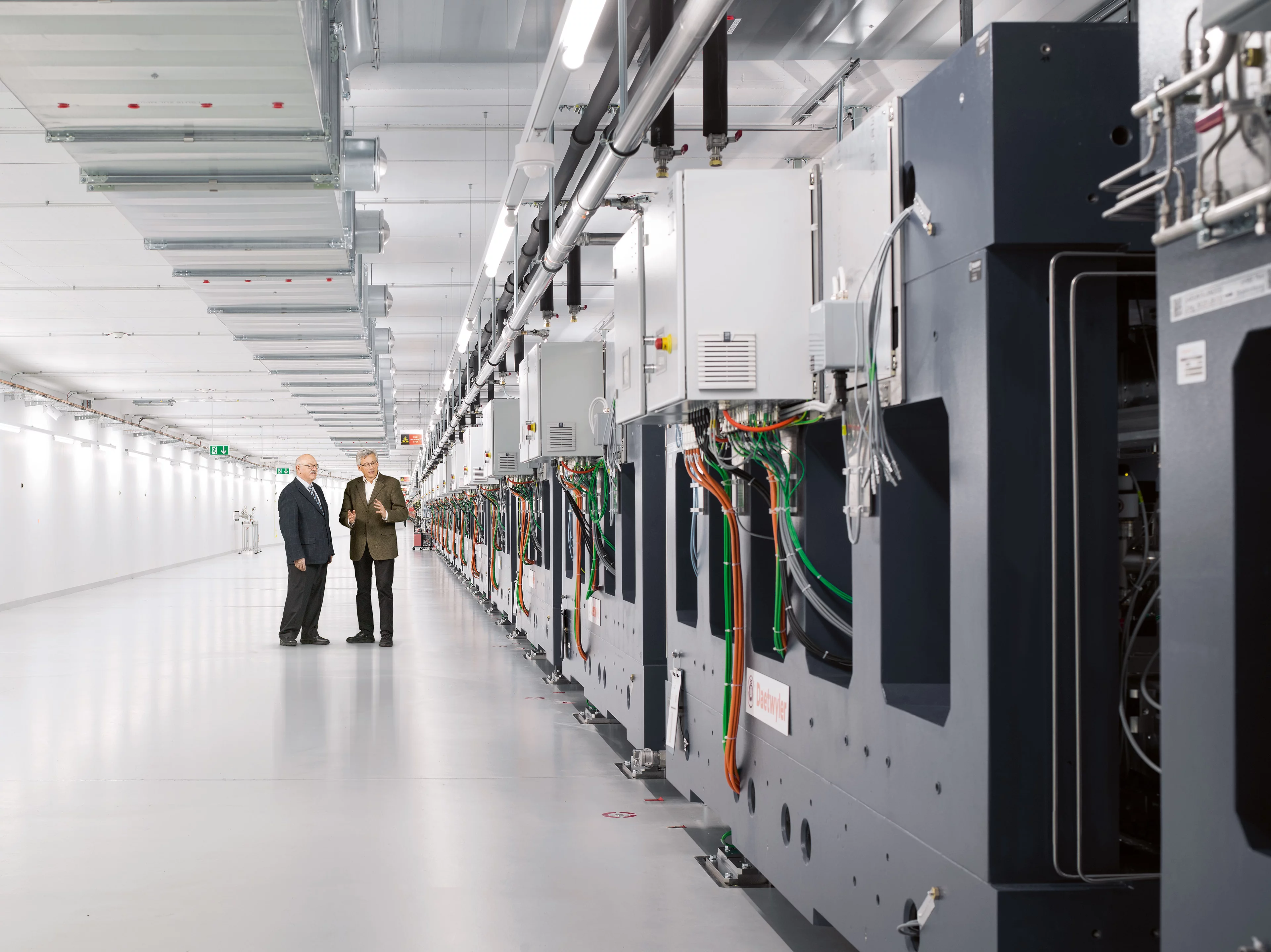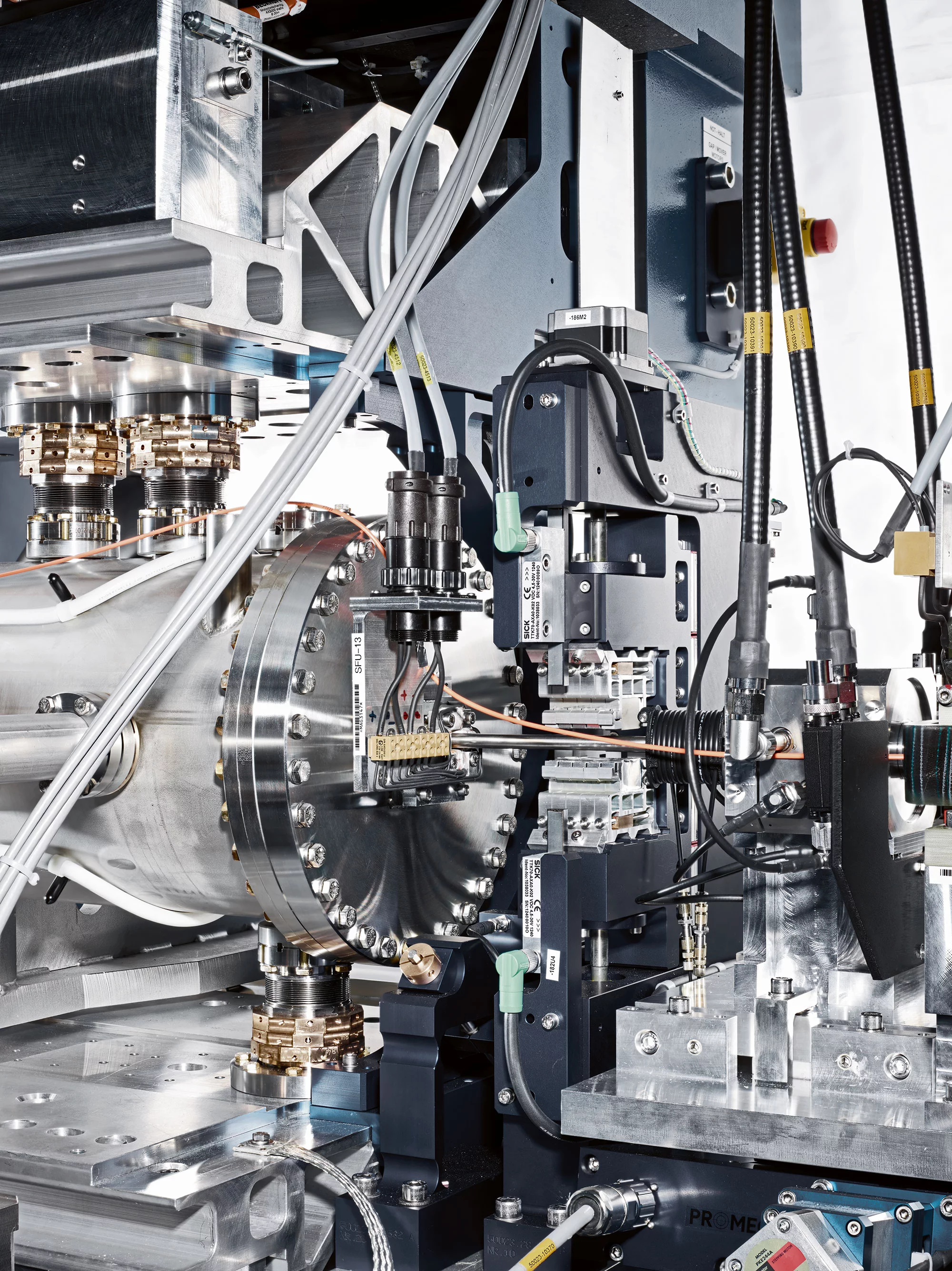First, the engineers and the physicists had to find each other. Then, however, the company Daetwyler built the undulators for the X-ray free-electron laser SwissFEL of the Paul Scherrer Institute PSI as precisely as was possible: to one-tenth of the width of a hair.
The headquarters of the Daetwyler Group are located next to the Bleienbach airfield near Langenthal, Switzerland. From here, Peter Daetwyler and his son Ralph, who took over last year, run their family business with more than 400 employees and nine locations, including the USA and China. Times are hard, with the strong franc giving overseas competition a cost advantage; the year before last, Daetwyler had to let 60 people go.
Peter and Ralph Daetwyler, as well as their project engineer Christian Nussbaum, are sitting in the executive office. Laid out before them are the folders with business cards and company brochures that have been prepared for the journalist's visit. Time is tight here; it almost seems one can feel the pressure of the world market hovering in the room. Still, when the men tell about their cooperation with PSI, they start to beam. That is a project that worked out well
, begins Peter Daetwyler.
Fifty kilometres to the northeast sit SwissFEL project leader Hans Braun and Thomas Schmidt, head of the group responsible for undulator development, in a cramped office at PSI. For the visit, they put a model of the undulators they have produced with Daetwyler on the table. As a team, Braun and Schmidt are mirror images; they correct each other, joke good-naturedly, and act a bit like absent-minded scientists while making coffee: Do you need capsules?
asks Braun. No
, replies Schmidt from the kitchen and comes back in. But cups.
When, after a brief search, they have found unused cups, Schmidt goes back to the kitchen, turns around again, and asks: Oh yeah – milk and sugar?
Physicists and engineers
PSI's cooperation with the company Daetwyler, which manufactures high-precision machinery for the printing industry, did not begin without scepticism. It necessitated the meeting of two worlds: that of the physicists and that of the engineers. Here the fundamental researchers, there the practitioners making products for the market.
The partners' story began in May 2009, when PSI invited several dozen companies to its campus. PSI had just finalised the decision to build a 740-metre-long X-ray laser at a cost of 275 million francs and was seeking manufacturers for the components. Especially tricky was the search for a company to make the undulators. In these devices, electrons are steered this way and that by a series of 1,060 magnets in such a way as to generate the desired X-ray light. Yet this only works if the components are installed with a precision of a few thousandths of a millimetre.
PSI could have entrusted this to a company in Japan, where one of the world's only two comparable X-ray lasers is located. However, we wanted to produce know-how here in Switzerland
, says PSI project leader Hans Braun. On that day when the prospective partners were invited to PSI, Daetwyler was not one of the firms PSI had in mind. But Daetwyler CEO René Hartmann's ambition was aroused. Without him, the cooperation never would have come about
, Hans Braun says today. Hartmann, who had written his doctoral dissertation at PSI, convinced Braun and his team that Daetwyler could make the 20-ton undulators with the needed precision.
Yet Hartmann also had to campaign for the cooperation back at Daetwyler's headquarters. Normally, we manufacture machines that are dirty after a month in service
, says project engineer Nussbaum, who completed his education at the technical school in nearby Burgdorf. This sterile world of scientific research was alien to us.
Aluminium instead of titanium
René Hartmann proved himself a spellbinding advocate. He swept us away, so that in the end we believed in it too
, Nussbaum recalls. Peter Daetwyler assigned several of his best people, who now met with the PSI researchers every two weeks. That took courage
, says SwissFEL project leader Hans Braun in retrospect. At the start, the cooperation was based on a handshake; the financing was not in place even for the prototype of the undulators. But for us it was a chance to expand into a new area
, says Peter Daetwyler, explaining why he was willing to take the risk. It was not until December 2011 that PSI and Daetwyler were able to sign the contract for the prototype. The funding for that came from a stimulus package for the export economy enacted by the Swiss government.
Nevertheless, the physicists and engineers first had to get on each other's wavelength. Daetwyler project engineer Christian Nussbaum grins when he describes one of the first meetings with the PSI physicists: We asked, 'How precise does the construction have to be?' They answered: 'Well, not accurate to the nanometre' and laughed. Then they got serious: 'But accurate to the micrometre – that will work, right?'
The Daetwyler engineers explained to the physicists that the degree of precision they wanted was not feasible.
They also had to bring the physicists down to earth on the choice of materials. Once they wanted to make the magnet guides out of titanium
, Nussbaum says. When they saw our price quote, they quickly asked if aluminium would also be OK.
Still, the Daetwyler team was quick to realise that, in the undulator developers at PSI, they were not dealing with impractical visionaries; their group head, Thomas Schmidt, had already taken part in construction of the PSI research facility SLS. On the other hand, the Daetwyler engineers also learned something new, because the PSI physicists drove them to the limits of their capability. At Daetwyler it was known that parts needed to be painted before assembly, because a coating applied later can cause a piece of equipment to become deformed. Because temperature swings can make a material expand or contract, the Daetwyler assembly hall was constantly heated to 24 degrees. For the undulators, however, the engineers discovered that the temperature needed to be exactly the same above and below, not only in the middle of the hall. So Daetwyler installed floor heating. Today, thanks to that, the company can assemble equipment for other customers more precisely than they could before.
Celebrating with the federal councillor
When the prototype of the undulators was assembled in 2013, Peter Daetwyler organised a joint celebration in the assembly hall. Even his friend Johann Schneider-Ammann, a member of the Swiss Federal Council, dropped in. In the meantime, financing had been secured for the 12 remaining undulators. Now production could start. By then the trust between the physicists and engineers had grown to the point where PSI left the acceptance inspection in the hands of Christian Nussbaum of Daetwyler.
The devices were transported in a freight container with air-cushion suspension and heating – and at night, because then the lorry could drive slowly. Thomas Schmidt of PSI went along on 11 of the 12 trips. Not because he had to, but because he wanted to be there.
In the summer of 2016, the last undulator was delivered, and SwissFEL was officially inaugurated shortly before Christmas. But the cooperation between Daetwyler and PSI continues. For the second beamline of the big X-ray laser, 16 undulators of a newly designed model are required. The game is starting over again: The Daetwyler engineers will explain to the PSI physicists what is and is not feasible. Already this summer, construction of the next prototype should be under way.
Thanks to this new competence, Daetwyler has already won other customers from the scientific community, including for example the Helmholtz Zentrum Berlin. These contracts have often come about as a result of recommendations from PSI. At Daetwyler, according to Hans Braun and Thomas Schmidt, the search for the best solution has always come first, instead of thinking mainly about the costs. This assignment, explains Peter Daetwyler, was not business as usual. It was an investment in our future. We have broadened our horizons.
Text: Joel Bedetti



